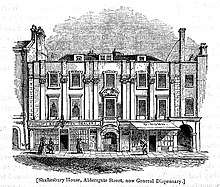General Dispensary, Aldersgate Street
The General Dispensary, Aldersgate Street, was a London dispensary which provided outpatient treatment and home-visiting for sick adults and children.

Background
By 1700, a few London dispensaries were opened and endorsed by the Royal College of Physicians when a number of physicians returned after the fire of London after fleeing London from the Great Plague of 1665 and when an increasing number of apothecaries were treating the poor, resulting in competition. The situation changed after the Rose case.[2][3] Eighteenth century London witnessed not just a building boom and extension of the city boundaries, but also a steep rise in poverty. By the end of the century, birth rates exceeded death rates and the population of London was 675,000 in the early part of the century and 900,000 in 1801. Public money spent on the poor increased disproportionately to the rise in population and reliance was put upon medical relief from private voluntary associations and philanthropy. In addition, the number of London hospitals increased but treatment was confined to within their walls and an unmet need for outpatient care of the poor contributed to the rise of the London dispensary.[4]
Origins
Following the popular dispensary opened within the Royal College of Physicians building at Warwick Lane and despite its closure in 1725, around 100 men provided the influence to create the General dispensary at Aldersgate street.[4]
The dispensary was situated at 36 Aldersgate Street, a building that had been built for the Marquis of Dorchester and subsequently became "Dorchester House". It later became the City of London Lying-in Hospital before being used as dispensary.[5]
It was founded in 1770[6] and opened by John Coakley Lettsom.[7]
James Sims was one of the physicians.[4][5]
Workings
It was well organised, well staffed and soon became successful.[4] Both physicians and apothecaries were hired.[7]
Premises
The dispensary was also known as the Aldersgate dispensary and renamed in 1844 as the Royal General dispensary. Six years later, the premises moved to 25 Bartholomews Close where it stood just shy of 30 years before being rebuilt. This new building was destroyed during the Blitz in 1941 and its workings continued at St. Bartholomew's hospital until 1948, when the dispensary came to an end.[6]
Later
It later became Shaftsbury House.[8]
See also
References
- Knight, Charles (Ed.) (1841-44) London. London: Charles Knight & Co.
- Debus, Allen G. (2001). Chemistry and Medical Debate: Van Helmont to Boerhaave. Science History. p. 176. ISBN 9780881352924.
- Cook, Harold J. (1 October 1990). "The Rose Case Reconsidered: Physicians, Apothecaries, and the Law in Augustan England". Journal of the History of Medicine and Allied Sciences. 45 (4): 527–555. doi:10.1093/jhmas/45.4.527. PMID 2246497.(subscription required)
- "The Aldersgate-Street Dispensary". The Medical Quarterly Review. 1 (1): 226–228. October 1833. PMC 5931064. PMID 30403081.
- Hartston W (August 1963). "Medical Dispensaries in Eighteenth Century London [Abridged]". Proceedings of the Royal Society of Medicine. 56 (8): 753–8. doi:10.1177/003591576305600839. PMC 1897424. PMID 14052474.
- "AIM25 collection description". aim25.com. Retrieved 29 December 2018.
- England, Historic. "Former Clapham General Dispensary, Non Civil Parish - 1184314 | Historic England". historicengland.org.uk. Retrieved 29 December 2018.
- Green M (30 August 2016). "Lost in the Great Fire: which London buildings disappeared in the 1666 blaze?". The Guardian. Retrieved 29 December 2018.